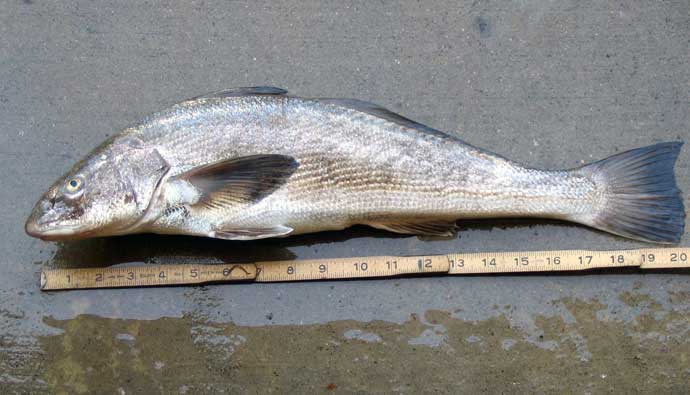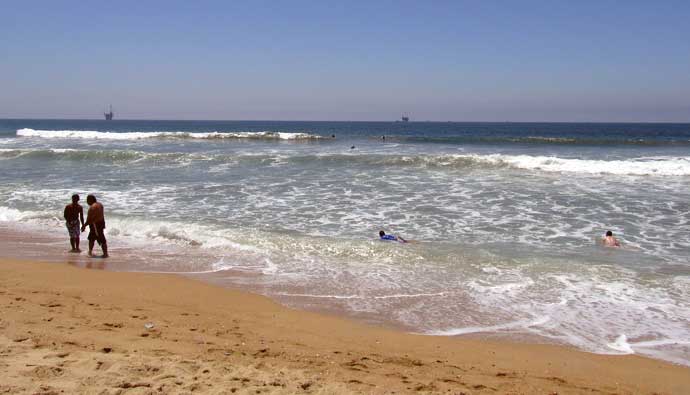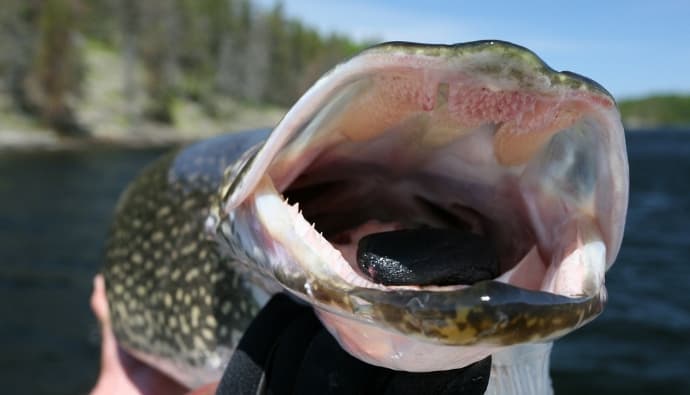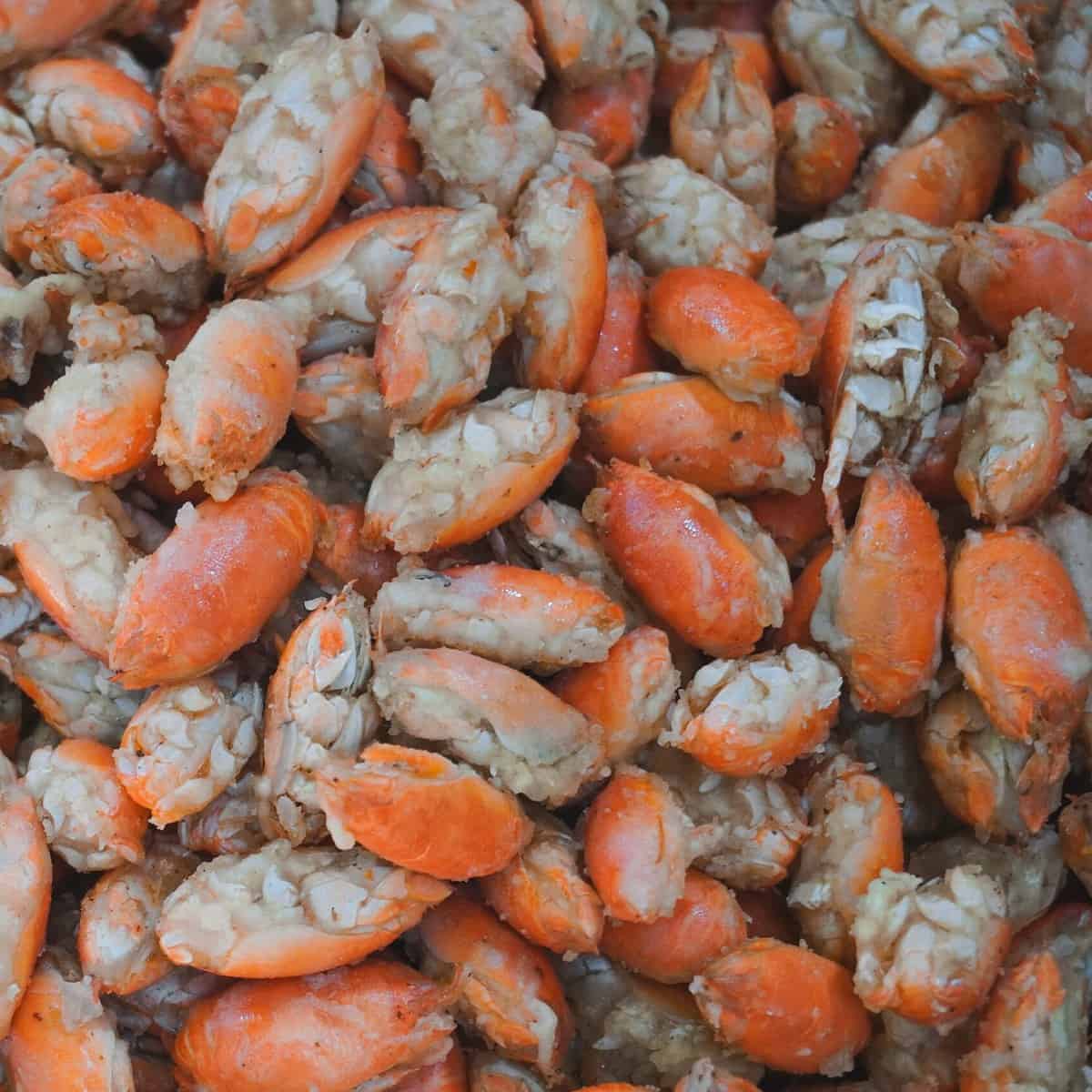California Corbina Fish is a marine fish that you can lure using soft-shelled sand crab, small pieces of shrimp, or innkeeper worms. Ideally, use a light tackle outfit from 7 feet up and a straight mono or around a 22-inch fluorocarbon leader. As for the hook, you can use a number 6 up to a 4/0 depending on your rig. Usually, live bait works better than a lure. These species are soft biters, so use a tight line without making your bait look unnatural. If you’re looking for them near shallow waters, use sight-casting. This makes it easier to see if the fish took your bait. If you’re not having much success, cast further out and pay special attention to the depressions under the surf.
Corbina is one of the most popular sportfish in Southern California. Hooking them is difficult as they are keen when taking the bait. To increase your chances of catching one, we’ve prepared a detailed guide on how to catch Corbina fish effortlessly.

Watch Out For Corbinas
If you happen to go fishing and see a long slender fish shaped like a cylinder with a chin barbel on its lower jaw- think of California Corbina. Their dorsal fins appear divided by a deep notch but connected by the membrane. Its color ranges from dark metallic blue to sooty gray on the back fading to lighter shades.
They have dark wavy diagonal lines on flanks; hence the Latin term ‘undulates’, black pectorals, and a white belly. King croakers grow up to 28 inches in length. Do not confuse it with its relative, the yellowfin croaker.
Recommended California Corbina Fishing Gear:
- Fishing Rod: St. Croix Triumph Spinning Rod
- California Corbina Fishing Reel: Pflueger President Spinning Reel
- Fishing Line: KastKing Monofilament 6 pound
- Best California Corbina Bait: Sand Crabs
Overview
California Corbina Menticirrhus undulatus swim to a depth of 45 feet, but usually in water 3-18 feet deep. Usually, in small schools, California Corbina fish are rarely in water deeper than 20 feet.
These fish tend to swim to shallow bays along sandy shorelines and oceanfront surf, and sometimes they swim in just inches of water while using the chin barbells found on their lower jaw to search for sand crabs.
Corbina usually go on a feeding rampage when the water temperature is around the sixties. You’ll find them along sandy beaches on the southern Pacific coast from Santa Barbara up to the south of the Mexican border.
From May through September (spawning begins in July), they are most commonly found in oceanfront surf areas. California Corbina fish are way more fun if you use a light tackle setup due to their fight.
The California Corbina is a resident of Mexican waters of the Pacific Ocean but has a limited distribution being found in waters from Bahia Magdalena, southern California, and the Gulf of California to Point Conception.
California Corbina feeds on the Coldwater Mole Crab, Emerita analog, and small amounts of other crustaceans and clams, small fish, and small invertebrates. It can often be found feeding in a few inches of water in the upper surf.
California Corbina Facts
| Scientific Name | Menticirrhus undulatus |
| Common Name(s) | Corbina, California Corbina, California Whiting, Corvina, Bagre, Surf Fish |
| Family | Sciaenidae |
| Identifying Characteristics | Greyish-blue top with metallic grey sides and white belly. Slightly wavy lines along the sides. Dusky fins. Older specimens have two stripes from head to tail above pelvic fins and merge behind the anal fins. Look for a barbel on the chin. |
| Depth Range | 0 to 20 m |
| Habitat | The fish can be found in Pacific waters from the Gulf of California to Point Conception. It’s one of the most sought-after sportfish on the Southern California coast. Sandy shore anglers visit beaches between San Diego and San Pedro for a good California Corbina fishing experience. |
| Limits | Check your local regulations |
| Largest Recorded | The largest recorded California corbina caught is 8 pounds 7 ounces. Generally, around 3 pounds. |
As of October 15, 2019, the International Game Fish Association world record stood at 56 cm (1 foot 10 inches) with the fish caught in coastal waters off Newport Beach, California, in April 2015, and 3.6 kg (7 lbs 15 oz) with the fish caught within Mission Bay, San Diego, California in May 2004.
The world record for the largest California Corbina fish was 8lb 7 oz, but according to Los Angeles Times, on August 30, 1904, a large pier-caught California Corbina was reported. It was caught by Harry Slotterbeck in Redondo Beach Wharf. The record fish weighed a stunning 11lbs and 2 Oz.
California Corbina Habitat

Most can be found in small schools, and some adults prefer to swim alone along the surf zone in a few inches of water. The fish swims along the sandy shallow bays looking for food and seeking refuge in the white water that is created by crashing waves. You can catch these fish while spin casting, sight fishing or surf fishing.
Some pier anglers or pier fishermen visit the sandy beach piers in Southern California during summer when California Corbina fishing is best occurring.
If you’re unfamiliar with beach piers, you can visit these best bet Corbina beaches in Southern California: Crystal Pier, Oceanside Pier, San Clemente Pier, Belmont Veterans Memorial Pier, Hermosa Beach Pier, Manhattan Beach Pier, Malibu Pier, and Goleta Pier.
Sandy shore anglers visit beaches between San Diego and San Pedro for a good California Corbina fishing experience. Considered one of the best sandy beaches for shore anglers is San Onofre.
How to Catch California Corbina Fish

The fish is an inshore species, so the best way to catch it is from the shore rather than a boat. Since corbina’s preferable food source are soft-shelled sand crabs, that is the best bait you can use to catch them. You can also use small pieces of shrimp and innkeeper worms.
Plus, use light to medium tackle with a high/low leader and size 6 to 4 hooks. This fish is frequently caught using a method called sight fishing.
Pier fishermen are at a disadvantage with California Corbina fishing because the angle, wind, and wave action make it hard to fish a spot without a heavy sinker.
But they definitely have lucked out on the fact that beds of sand crabs can be spotted near the beach piers during low tide, the areas the Corbina will invade and seek out food as the tide moves inshore.
California Corbina Tackle
Rod Type
Use a light tackle outfit if you’re looking to play a bit with the fish. Depending on your preference, you can get away with a light to medium rod from 7 feet up.
Line
Use straight mono or with around a 22-inch fluorocarbon leader. For an added challenge, use a 4-6 pound test. Since the fish usually rides the incoming tide to the sandy shores while looking for food, use sight-casting for fishing for them.
Hooks
Hooks can vary from a number 6 up to a 4/0 depending on your rig. Generally, a smaller hook would be advisable with a light line.
Bait
Use one or two sand crabs on your hook. If that doesn’t work, try clams, mussels, or marine worms. Usually, live bait works better than a lure. If you can find innkeeper worms, use them, as they are also considered one of the best baits for Corbina fishing.
Corbina Fishing Tactics
- If this croaker fish is not feeding far up on the beach, cast further out and pay special attention to the depressions under the surf. Look for those that are parallel to the beach.
- Corbina will flee at the slightest threat. Make sure that the line is tight so you can detect the smallest bite without making the bait seem unnatural. Plus, keep the rod tip high and keep moving up the beach if a spot doesn’t, please.
- Sight-casting is advised. A well-placed cast can ensure you can watch the fish take the bait. To spot the fish from a pier or the shore, wear polarized sunglasses to block the sun’s ray’s reflecting off the water. The best way to spot them is from a local pier, especially when the tide is high.
Corbina Fishing Tips
- Use small, dime-sized sand crabs as bait rather than the large ones, or you will have to spend more time cutting up bait than fishing.
- For live bait, use the fish’s favorite meal, such as bloodworms, mussels, ghost shrimp, sand crabs, and bean clams.
Corbina Fish Season
Corbinas can be taken all year round, but the most optimal time is July through October, with the influx of warm water and sand crabs.
From mid-July to late September, Corbina fish bite in droves. The former brings smaller surf and clear waters, which the fish uses to full effect in feeding frenzies.
You can catch it at any time of day, but Corbina is another croaker that often bites far better at night or early morning in low-light conditions.
How to Clean Corbina
Corbina has a food value of good to excellent. Therefore, if you catch a keeper, it’s worth bringing it home to cook.
- Place the corbina on a clean cutting surface and use a large and very sharp fillet knife to cut off the head completely.
- Starting from the top where the head was, run the knife along the spine and make several passes down to the tail.
- Make as many passes of the knife as it takes to remove the first fillet from the body.
- Separate the second fillet from the rib cage by sliding the knife between them and making several passes till it detaches.
How to Cook California Corbina
Croakers Fish Recipe
- Cut up the fish into small pieces before washing and drying it. Place in a plastic container.
- Sprinkle on some salt and pepper.
- Cover the fish with 2 finely sliced red onions, 2 steamed and seeded Serano chilies, and some lemon juice. Marinate for 3 hours in the fridge.
- Boil a pot of salted water and boil 4 ears of corn for 4 minutes. Drain and set aside.
- Place some lettuce leaves on a plate, place the fish mixture on top and surround it with the cooked corn before serving.
Frequently Asked Questions
Yes, corbina has a good mild taste that is pleasant to the palette.
Yes, this fish is safe to eat.
Corbina can grow to be as large as 30 inches in length and as heavy as 8 lbs.
The corbina is often confused with the yellowfin croaker and other croaker varieties because of its similarity to them. Yet, it does belong to the croaker family.
It is illegal to buy corbina commercially in the state of California, so you will have to catch the fish yourself.
Insider Advice
Corbina can be some of the most exciting surf fish to catch along the Southern California coastline if you have the right setup and the proper know-how. To increase your chances of catching this fish, match your bait with the prey it hunts along the shallows.
Be ready to put up a fight, though. This croaker fish is an aggressive fighter and may give you a hard time when it is hooked.
Do you have any tips and strategies that you use to catch California corbina? Or maybe an experience you’ve had in fishing? Share them in the comments, and do share this guide if you liked it and found it informative.
Resources
- https://escholarship.org/uc/item/5f28f44g
- https://biogeodb.stri.si.edu/sftep/en/thefishes/species/1480
- https://www.pierfishing.com/california-corbina/
- https://mexican-fish.com/california-corbina/
- https://fishingbooker.com/fish/california-corbina
- https://surffishingsocalsd.com/california-corbina-fishing-southern-california/




 Facebook
Facebook YouTube
YouTube








